

Diverse Book Audits: A Step-by-Step Guide - Library Events - South Carolina State Library. Description: Doing a diverse book audit does not have to be overwhelming.
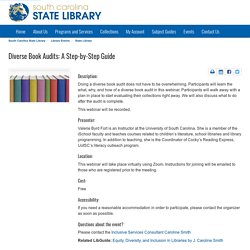
Participants will learn the what, why, and how of a diverse book audit in this webinar. Participants will walk away with a plan in place to start evaluating their collections right away. We will also discuss what to do after the audit is complete. This webinar will be recorded. Presenter: Valerie Byrd Fort is an Instructor at the University of South Carolina. TeachingBooks (requires subscription) Inclusive Services Center - Equity, Diversity, and Inclusion in Libraries - Subject Guides at South Carolina State Library. The Inclusive Services Collection houses materials related to diversity, equity, and inclusion in library services.
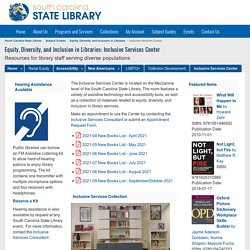
The collection includes suggested fiction for children and youth from diverse backgrounds, non-fiction resources for library staff working with all ages, and materials in accessible formats such as braille and sensory books. Most materials may be checked out with a State Library card or requested through SCLENDS. View the Inclusive Services Collection on the SCLENDS catalog. How to Diversify Your Kidlit Related List Chris Barton. Module 24b: Transforming Library Collections Part 2 – Project READY: Reimagining Equity & Access for Diverse Youth. After working through this module, you will be able to: Discuss some of the key topics that must be considered when collecting diverse texts.Develop a plan to stay up-to-date with and address these topics and others that may arise.
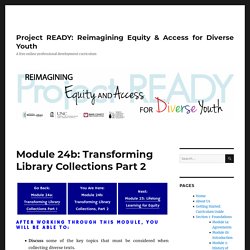
Introduction There are a number of important topics that need to be considered when collecting diverse texts. In this module, we will highlight several of them for you to think about and act on. Diverse BookFinder Collection Analysis Tool (CAT) Mackin Diversity Audit (requires login) Mackin Tag Report. Read in Color - Little Free Library. Finding Diverse Books - A Book And A Hug. CCBC Diversity Statistics Book Search - Cooperative Children's Book Center. Take Action: Diversity Audit - Google Docs. MISelf in Books (Guiliano & Hincks) American Indians in Children's Literature (AICL)
*A Thank-You to Librarians Who Make Everyone Feel Welcome. Black Librarians Speak Out. You searched for diversity - Teen Librarian Toolbox. When I first began doing collection diversity audits, I had no idea that was what they were called.

It was actually SLJ editor Kathy Ishizuka who gave me a name for what I was doing. Graphic novels help teens learn about racism, climate change and social justice – here’s a reading list. This article is republished from The Conversation under a Creative Commons license.
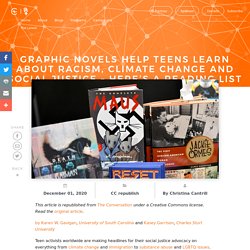
Read the original article. by Karen W. Gavigan, University of South Carolina and Kasey Garrison, Charles Sturt University Teen activists worldwide are making headlines for their social justice advocacy on everything from climate change and immigration to substance abuse and LGBTQ issues. As young people get more vocal about these issues, this trend is being reflected in the graphic novels they are reading. It’s a relatively new genre. Later, the cartoonist Art Spiegelman created “Maus,” which relayed his father’s experiences during the Holocaust through pictures in which Jews were mice, Germans were cats and Poles were pigs. Sales have soared since then. Because the combination of text and images in graphic novels can communicate issues and emotions that words alone often cannot, more educators and parents are finding them to be effective tools for tackling tough issues with kids.
Doing a YA Collection Diversity Audit: Resources and Sources (Part 3) - Teen Librarian Toolbox. In this final post on doing my diversity audit, I just wanted to share my sources and resources with you.
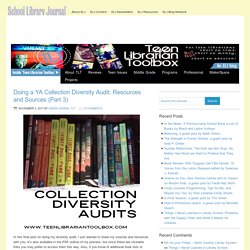
It’s also available in the PDF outline of my process, but since these are clickable links you may prefer to access them this way. Also, if you know of additional book lists or titles that you would like to recommend, please add them in the comments. Reading While White: The Benefits & Limits of Diversity Audits. This is a post in Reading While White’s end-of-year retrospective series.

Diversity audits! They’re an analytical look at a library collection through a diversity lens: tracking minority representations vs. majority. This can cover a variety of identity markers, but generally what is talked about most is numbers of BIPOC and White creators/ characters. These audits aren’t totally a new thing, but they’ve gained traction over the last year with Karen Jensen’s posts giving guidelines on how-to (also see her more recent post) and Library Journal’s online course “Equity in Action: Taking Your Diversity and Inclusion Initiatives to the Next Level” delving into the subject.
I myself have started doing diversity audits, and it’s something my library is pushing for us to continue. Hi! AB Kids: The Augusta Baker Storytelling Experience: Diversity, Equity, and Inclusion Programming for Children of All Ages (AB Kids) The Augusta Baker Endowed Chair at UofSC’s School of Information Science and the South Carolina Center for Community Literacy are pleased to announce The Augusta Baker Storytelling Experience: Diversity, Equity, and Inclusion Programming for Children of All Ages (AB Kids) beginning in the Fall of 2021.
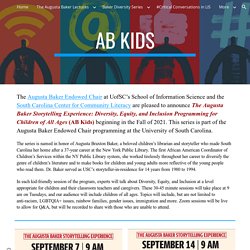
This series is part of the Augusta Baker Endowed Chair programming at the University of South Carolina. The series is named in honor of Augusta Braxton Baker, a beloved children’s librarian and storyteller who made South Carolina her home after a 37-year career at the New York Public Library. The first African American Coordinator of Children’s Services within the NY Public Library system, she worked tirelessly throughout her career to diversify the genre of children’s literature and to make books for children and young adults more reflective of the young people who read them.
Dr. Black Creators Series. Does My Collection Reflect My Community? Diversity in the School Library. Shannon McClintock: Welcome, everybody, to our Future Ready Librarian Webinar.

I’m so excited for our April webinar. And as you know, my name is Shannon McClintock Miller. I am the district teacher librarian at Van Meter Community School in Iowa and the Future Ready Librarians Spokesperson. Also, you can find me on my blog at The Library Voice and on Twitter and Instagram @shannonmmiller. And so we’re so excited to have everybody here for this webinar, and we’re now into the third year. And so we’ve had quite a few. Also, I wanted to just share the #FutureReady, as well. And so it’s always good to, I think, include those in the conversation, as well, not just us as librarians. And so you can go there to check out more, and at the end I will tell you a little bit too about that website, because there’s lots of great things on there, as well.
And it’s going to be focused on, I think, one of the most exciting things that have happened to our framework. Matthew Winner: Hi, everyone. How Labeling Books as “Diverse” Reinforces White Supremacy. In this guest post, librarian Alexandria Brown discusses the issues with labeling books as “diverse” and other ways we can build and promote a more equitable library collection.

Every so often, the question of whether or not to add a spine label designating “diverse” books makes the rounds. Many condemn the practice, but lots of library staff persist in labeling. Like most diversity, equity, and inclusion (DEI) issues in librarianship, many of my colleagues are still operating within a white (and cisgender and heterosexual) supremacist framework. It is an understandable predicament to be in – after all, many library degree programs are not as strong as they could be in advocating for DEI and decolonization. So let’s examine the question of diversity labeling and see if we can’t get to a better understanding of why it’s problematic. Before we dive in, I want to make sure a few things are clear. Now, let’s begin. Asians in Children's Lit. A Frank Conversation about Diversity in Library Resources (SLC) Library/Media Center / Diversity Audit.
Diversity Audit: During the 19-21 school year I began a comprehensive "Diversity Audit" on the fiction collection of our library. The initial audit was completed in Fall 2020. Going forward I will continue to audit the collection each year, including the newly purchased items. You will be able to view the current data on this page, as it will be updated each year. Freedom Reads: Anti-Bias Book Talk Series. Diversity Audit: A Practical Guide. Diversity Audit 2 – Sci-Fi. Read part 1 of the Diversity Audit blog series here! Read part 3 of the diversity audit blog series here! As you know from my last post I have begun a comprehensive and extensive Diversity Audit on my high school library’s fiction collection. I have decided to do the diversity audit by genre first, so that I will have data on the diversity of each individual genre.
This information will help immensely with my collection development efforts going forward. Diversity Audit 3 – Mystery & Horror Genre. Read part 1 of the Diversity Audit blog series here! Read part 2 of the Diversity Audit blog series here! As you know from my last post I have begun a comprehensive and extensive Diversity Audit on my high school library’s fiction collection. I have decided to do the diversity audit by genre first, so that I will have data on the diversity of each individual genre. This information will help immensely with my collection development efforts going forward.
Diversity Audit & A Conversation with Madelyn Rosenberg & Wendy Shang: Books Between, Episode 28 – All The Wonders. First up is how things went when I did a diversity check of my classroom library. If you listened to the last episode (#27 with librarian Sarah Threlkeld) you heard us chatting about this activity she did with her students to reflect on the diversity found in their school library. And I think even way back to Episode 18, I mentioned reading this fantastic blog post over at Lee & Low Books that shared how one teacher helped her class analyze the books in their room to find out how different genders and races are represented.
I’ll include a link to that article and the main framework of what I did is pulled directly from there. So I want to be clear – this is not my idea, but I’m sharing how it went for me with the idea that you might want to try it, too. First I’ll run through the process and then discuss my major takeaways, and how I’ll do it differently next year.
First, I showed my 5th graders two infographics. Diversity Audit Outline 2017 with Sources. Diversity Audits - AASL - Google Slides. Multicultural and Social Justice Books. MISelf in Books: A Diverse Book List for All. Recently, the Michigan Association for Media in Education (MAME) released the 2020 MISelf in Books List. MAME is an affiliate of AASL and works with librarians across the state of Michigan. The MISelf in Books List is an annual list of diverse books that were selected by a committee of certified school librarians who are members of MAME. MIself In Books App. A Great Big List of MG and YA Collection Development Resources. “Mirrors, Windows, & Sliding Doors”
Diversifying Your Classroom Book Collections? Avoid these 7 Pitfalls - MindShift. Middle grade: Farah Rocks Fifth Grade by Susan Muaddi Darraj, Clean Getaway by Nic Stone, Ways to Make Sunshine by Renée Watson Young adult: A Phoenix First Must Burn edited by Patrice Caldwell, Wicked Fox by Kat Cho, With the Fire On High by Elizabeth Acevedo. Black Lives Matter at School_Resources (Judi Moreillon)
I am providing these resources to support #BLMatSchool Week of Action: February 1 - 5, 2021. Gale eBooks: LGBTQ/Diversity - Gale. The Windows and Mirrors of Your Child's Bookshelf. LGBTQ eBook Collection: Gale/New York City School Library System. 30 Essential LGBT+ Books for YA Readers. Tips for Teachers: Developing Instructional Materials about American Indians.
Editors Note: This post was created as a one-page document that would fit into a single page. It is also available as a pdf. Denver Public Schools Selection Audit for Creating Inclusive Collections. Diverse BookFinder Collection Analysis Tool (CAT) Beyond the Collection Diversity Audit: Inclusion is More Than a Book, Why we should be auditing all of our library services for inclusion and best practices.
Introducing Own Voices as an appeal term in NoveList. October 22, 2018 Big news, folks! Own voices is now a searchable appeal term in NoveList. Where to Find Diverse Books. Resources for Race, Equity, and Inclusion. We Need Diverse Books – weneeddiversebooks.org. Take Action: Diversity Audit. Reading Diversity. Honoring Black Lives Virtual Library - Google Slides. Serving Diverse Learners in the Library Media Center (KC Boyd) Module 24a: Transforming Library Collections Part 1 – Project READY: Reimagining Equity & Access for Diverse Youth. After working through this module, you will be able to: Explain to your faculty, staff, administrators, and parents/caregivers the value of diverse and reflective literature.Evaluate your library’s collection through a racial equity lens.Collaboratively develop a plan to improve your library’s collection to better serve BIYOC.
Introduction. Module 24b: Transforming Library Collections Part 2 – Project READY: Reimagining Equity & Access for Diverse Youth. The Brown Bookshelf. Lee and Low: Checklist: 8 Steps to Creating a Diverse Book Collection. It’s not easy to create an inclusive book collection. Whether you’re a librarian creating a collection for an entire community, a teacher creating a collection for your classroom, or a parent creating a collection for your children, choosing books that reflect the diversity of human experience can be a challenging job.
Lee & Low Books (leeandlow) on Pinterest. 2020 Diverse Summer Reading List. Moving Multicultural Collections Online. Social Justice Books. Diversifying Reading Lists. Smithsonian Asian Pacific American Center. Hijabi Librarians – We've got it covered. I'm Here. I'm Queer. What the Hell do I read? Association for Library Service to Children (ALSC) The Coretta Scott King Book Awards. Association for Library Service to Children (ALSC) American Indian Youth Literature Award - American Indian Library Association.
Rainbow Book List. Tomás Rivera Book Award: Mexican American Children's Book Award. Freeman Book Awards - NCTA. Ezra Jack Keats Award (multicultural literature) Americas Award @ CLASP, Consortium of Latin American Studies Programs. Asian Pacific American Librarians Association. Rich in Color – Reading & Reviewing Diverse YA Books. American Indians in Children's Literature (AICL) Exploring the world of Latinx YA, MG, & children's literature. CrazyQuiltEdi (Edi Campbell:I blog to make IPOC authors and their works more accessible, to make all the pieces fit together).
Corinne Duyvis. Picture This: Diversity in Children’s Books 2018 Infographic – Sarah Park Dahlen, Ph.D. OwnVoicesSlides. The Problem With #OwnVoices LGBTQ Lit.